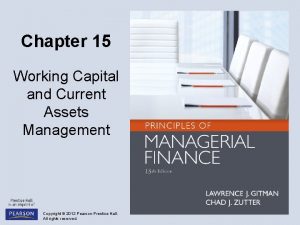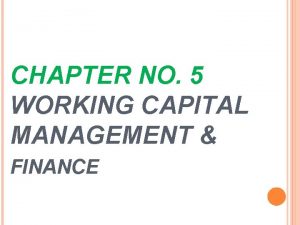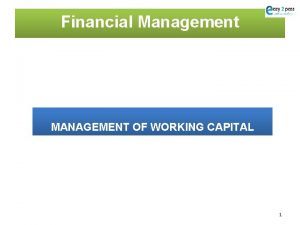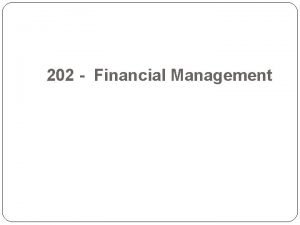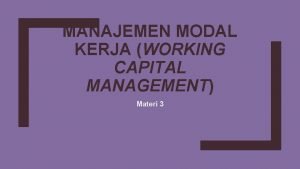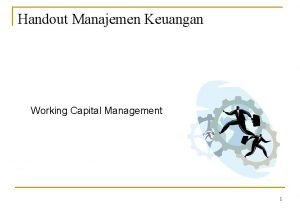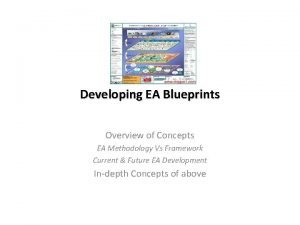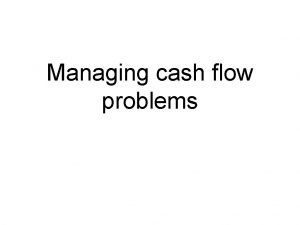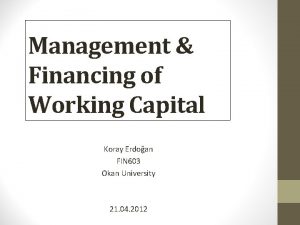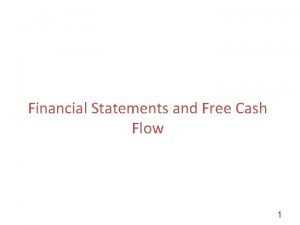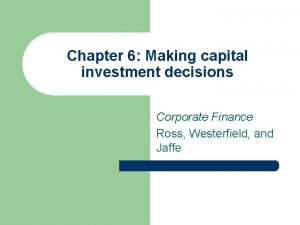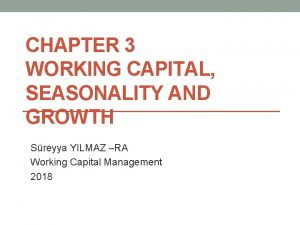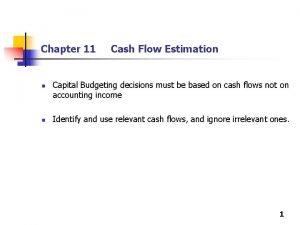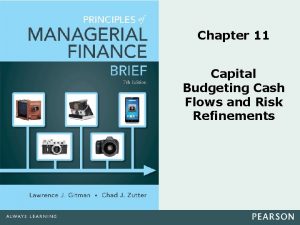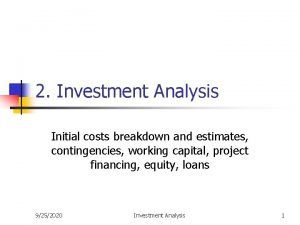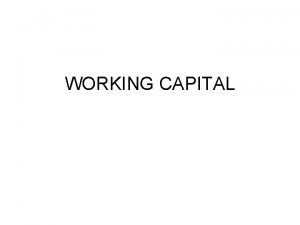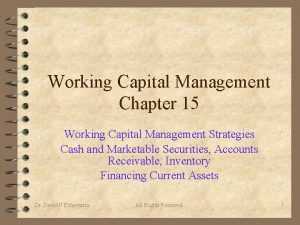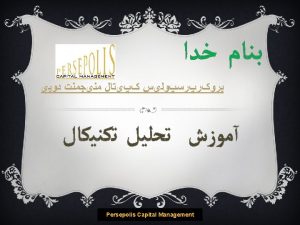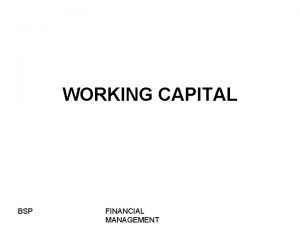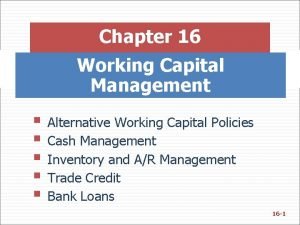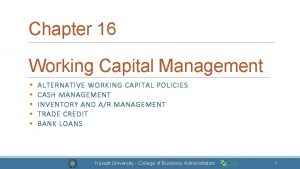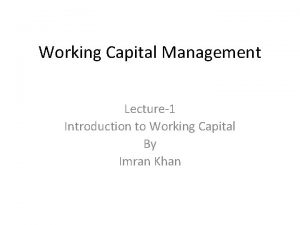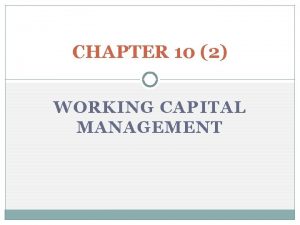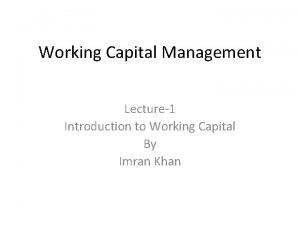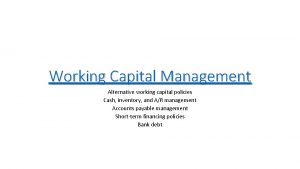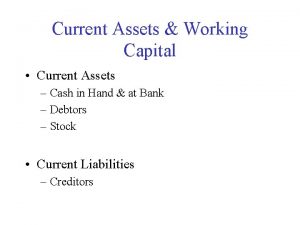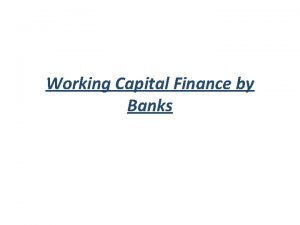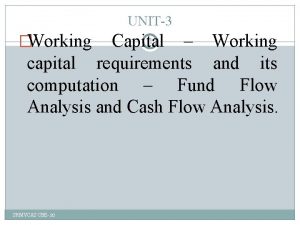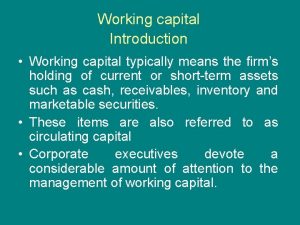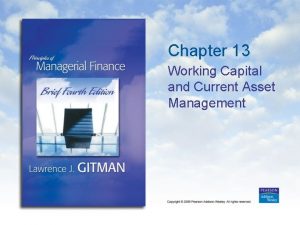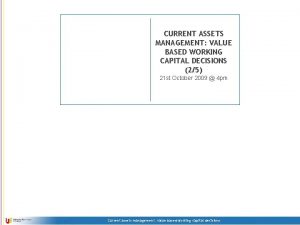WORKING CAPITAL MANAGEMENT Components of Working Capital Current






































- Slides: 38

WORKING CAPITAL MANAGEMENT

Components of Working Capital Current Assets & Current Liabilities are collectively known as WORKING CAPITAL Cash & Marketable Securities: Cash: Dollar Bills & Bank Deposits. DEMAND DEPOSITS: Money in checking accounts that the firm can pay out immediately. TIME DEPOSITS: Money in saving accounts that the firm can pay out only with a delay. Marketable Securities: Commercial Paper & Tresury Bills Accounts Receivable: arise because of companies do not usually expect customers to pay for their purchases immediately. These unpaid bills are a valuable asset that companies expect to be able to turn into cash in the near future. TRADE CREDIT : Unpaid bills from sales to other companies. CONSUMER CREDIT : Sales of goods to the final customers.

Components of Working Capital Accounts Payable: Unpaid Bills Outstanding payments due to other companies One firm’s credit is another firm’s debit NET WORKING CAPITAL CURRENT ASSETS – CURRENT LIABILITIES Generally called as WORKING CAPITAL

CASH RECEIVABLES CASH CONVERSION CYCLE INVENTORY FINISHED GOODS CASH CONVERSION CYCLE = (Inventory Period + Receivables Period) – Accounts Payable Period

CASH CONVERSION CYCLE = (Inventory Period + Receivables Period) – Accounts Payable Period CASH CONVERSION CYCLE : Period between firm’s payment for materials and collection on its sales Inventory Period = Average Inventory / [Cost of Goods Sold / 365] Receivables Period = Average Accounts Receivables Payable Period = Average Payable / [Sales / 365]

Carrying Costs: Working Capital Trade-off Costs of maintaining Current Assets; including opportinity cost of capital. Investment in CASH & RECEIVABLES may cause an interest loss and Investment in INVENTORY has opportinity cost of capital; storage & insurance costs Carrying Costs encourage firm to hold current assets to a MINIMUM Shortage Costs: Costs incurred from shortages in Current Assets Shortage in CASH may incur unnecassary transaction costs of selling marketable securities and Shortage in RECEIVABLES may cause to lose customers because of credit sales’ restrictions Shortage in INVENTORY may have shut down production & unable to to fill orders promptly Shortage Costs encourage firm to hold current assets to a MAXIMUM It’s an art to find the LEVEL of CURRENT ASSETS that minimizes the sum of Carrying Costs & Shortage Costs

Links between Total Capital Requirement LONG-TERM & SHORT-TERM fınancıng Short-Term financing Seasonal component of required assets Long -Term financing Time Firm’s Total Capital Requirement: The Cost of Assets STRATEGIES: 1. Matching Maturities: Long-Lived assets with long-term debt & Current Assets with short-term debt 2. Permanent Working Capital Requirements: A positive amount of WORKING CAPITAL 3. The Comforts of Surplus Cash: The firm is always a short-term lender (Relaxed Strategy)

TRACING CHANGES IN CASH & NWC Cash Budgeting: Forecasting future sources and uses of cash Alerts for future cash needs & provides a standart Three Common Steps to preparing Cash Budget 1. Forecast the sources of cash 2. Forecast the uses of cash 3. Calculate whether the firm is facing a cash shortage or plus

DETAILS: The Steps of Calculating Sources of Cash 1. Receivables at the start of period 2. Forecast Sales 3. Forecast Collections • Sales in current period (%? ) • Sales in last period (%? ) TOTAL COLLECTIONS 4. Receivables at the end of period 5. Other sources of cash (Dispose of land, machine, stock) Ending Accounts Receivable = Beginning Acc. Rec. + Sales - Collections

DETAILS: The Steps of Calculating Uses of Cash 1. Payments for Accounts Payable 2. Labor, Administrative and Other Expenses (Regular Business Expenses) 3. Capital Expenditures (Pay for long-lived assets) 4. Taxes, Interest and Dividend Payments Prepare SOURCES & USES CASH LIST each period Determine Short-Term Financing Requirements

DYNAMIC MATTRESS'S FINANCING PLAN 1. Quarter 2. Quarter 3. Quarter 4. Quarter TOTAL 86, 5 80, 3 121, 0 128, 0 415, 8 Cash Outputs 131, 5 95, 3 95, 0 93, 0 414, 8 Cash Balance 45, 0 15, 0 26, 0 35, 0 1, 0 Cash Inputs Marketable Securities Bank Loan 2% 5, 0 40, 0 Interest Payment Stretch 5% Cash Balance Additions to Cash Balance 5, 0 45, 0 8, 6 31, 4 40, 0 0, 8 1, 6 0, 6 3, 0 15, 8 15, 0 26, 0 0 32, 0 3, 0

QUESTIONS: 1. Cash or Marketable Securities enough or expand? 2. Does plan cahnge Current & Quick Ratios? 3. Hidden costs to stretching payables? 4. Does plan leave DYNAMIC in good financial shape for 2005? 5. What about log-term financing and capital expenditures? 6. Can the firm’s operating and investment plans be adjusted to make the short-term financing problem easier? SHORT-TERM FINANCING PLANS MUST BE DEVELOPED BY TRIAL & ERROR !. . .

SOURCES OF SHORT-TERM FINANCING Bank Loans: Line of Credit: Aggrement by a bank that a company may borrow at any time up to an established limit. Revolving Credit Aggrement: If the firm wants to be sure it will able to borrow; it can enter a RCA. ( RCA usually last for a few years and formally commit the bank to an aggreed limit. A committment fee is required on any unused amount. ) Term Loans: Conditional Credit (Loans are paid when the goods are sold) Syndicate Credit: Banks combined to provide cash Commercial Paper: Short-Term unsecured notes issued by firms

SOURCES OF SHORT-TERM FINANCING Secured Loans: Accounts Receivables Financing 1. Some companies solve their financing problem by borrowing on the strength of their current assets!. . . When a loan is secured by receivables, the firm assigns the receivables to the bank. The risk of default on the receivables is therefore borne by the firm 2. Others solve it by selling their current assets!. . . An alternative procedure is to sell the receivables at a discount to a financial institution known as FACTOR and let it collect the money. Once the firm has sold receivables, the factor bears all the responsibility for collecting on the accounts!. . . Inventory Financing Bank also lend on the security of inventory; but they are choosy about the inventory they will accept!. . .

THE COST OF BANK LOANS Simple Interest 1. Simple Interest: The interest rate on bank loans frequently is quoated on APR 2. Discount Interest : The interest rate on bank is often calculated on a discount basis. 3. Interest with Compensating Balances: Occasionally, bank loans require the firm to maintain some amount on balance at the bank, which is called as Compensating Balance. The reason is that borrower must pay interest on full amount borrowed but has access only part of the funds. In each case; the face value of the interest has to be converted to effective interest rate in order to learn the actual burden on the loan.

CASH & INVENTORY MANAGEMENT

Cash & Inventory Management Cash Collection; Disbursement & Float PAYMENT FLOAT: Checks written by a company that have not yet cleared. Company’s Ledger Balance 800, 000 + Payment Float 200, 000 Banks Ledger Balance 1, 000 AVAILABILITY FLOAT: Checks already deposited that have been cleared Available Balance 1, 000 + Availability Float 120, 000 Banks Ledger Balance 1, 120, 000 NET FLOAT: Difference between Payment & Availability Float NET FLOAT = 200, 000 - 120, 000 = 80, 000 Valuing Float: Float results from delay between your writing a check and the reduction in your bank balance. The amounf depends on the size of check & delay in collection. Playing the float: To hold more funds in interest earning accounts!. .

Managing Float Delays that help the payer hurt the receipent. Receipents try to speed up collections. Payers try to slow down disbursements. Both attempt to minimize NET FLOAT Check Mailed Mail Float Receipents see delays a availability float Payers see delays as payment float Check Received Processing Float Check Deposited Check clears Check Available to receipent Check clears Check charged to payer’s account

SPEEDING UP COLLECTIONS Concentration Banking: System whereby customers make payments to a regional collection center which transfers funds to a principal bank. Lock-box system: System whereby customers make send payments to a post office box and a local bank collects and processes checks. Controlling Disbursements Speeding up collections is not only way to increase the net float. You can also do this by slowing down disbursements. • Increase Mail Time • Remote Disbursement • Zero Balance Account: (Regional Bank Account to which just enough funds are transferred daily to pay each day’s bills) • Electronic Fund Transfer (About %14 of business to business payments, especially big companies use electronic payments) • ACH (Automated Clearing House) : (Bulk payments such as wages; dividends; payments to suppliers travel through ACH) (ACH is easy, transaction costs are very low, float is drastically reduced. )

INVENTORIES & CASH MANAGEMENT Cash Management involves a Trade-off If the cash is invested in securities, it would earn interest. On the other hand, you can’t use securities everytime to pay firm’s bills. If you had to sell those securities everytime you needed to pay a bill, you would incur heavy transaction costs. The art of cash management is to balance these costs and benefits!. . Managing Inventories Total Costs = Order Costs + Carrying Costs Level Orders Carrying costs 3 TL 24 1 72 3 75 12 2 36 6 42 8 3 24 9 33 6 4 18 12 30 4, 8 5 14, 4 15 29, 4 4 6 12 18 30 3, 4 7 10, 3 21 31, 3 3 8 9 24 33 2, 7 9 8 27 35 2, 4 10 7, 2 30 37, 2 Order costs 3 TL Total Costs Carrying Costs Order Costs Number of Orders When Orders increases; Order costs increases but Carrying costs decreases ECONOMIC ORDER QUANTIY = Order size that minimizes total inventory costs!. . . = [ ( 2 * Annual Sales * Cost Per Order * ) / Carrying Costs ]^(1/2)

INVENTORIES & CASH MANAGEMENT Cash Management involves a Trade-off If the cash is invested in securities, it would earn interest. On the other hand, you can’t use securities everytime to pay firm’s bills. If you had to sell those securities everytime you needed to pay a bill, you would incur heavy transaction costs. The art of cash management is to balance these costs and benefits!. . Managing Inventories of Cash Simple Inventory Models can tell us something about the management of Cash Balances Total Costs = Cost of per sale of securities + Interest rates INITIAL CASH BALANCE = [ ( 2 * Annual Cash Outflows * Cost Per Sale of Securities ) / Interest Rates ]^(1/2) Basic Trade-offs of Cash Management • When the cost of selling securities is high, you should hold larger average cash balances • When interest rates are high, you should hold smaller cash balances • When annual cash outflows increase, the optimal level of cash incresases less than proportionally

Uncertain Cash Flows If cash flows are unpredictable, the cash balance should be allowed to meander until it hits an upper or lower limit. Upper Limit C a s h B a l a n c e Return Point Lower Limit Time At this point the firm buys or sells securities to restore the balance to the return point. The lower limit plus one-third of the spread between the upper and lower limits.

INVESTING IDLE CASH Money Market: Market for short-term financial assets. Only fixed income securities with maturities less than ONE year!. . . These securities are highly marketable or liquid. Managing Inventories of Cash Simple Inventory Models can tell us something about the management of Cash Balances Total Costs = Cost of per sale of securities + Interest rates MAIN TYPES OF MONEY MARKET SECURITIES COMMERCIAL PAPER: Registrated by SEC with maturities of less than 2 months CERTIFICATES OF DEPOSIT: CDs are time deposits at bank, usually in denominations greater than $ 100, 000 REPURCHASE AGGREEMENTS : Repos, repurchase aggreements are in effect collateralized loans and are usually very short-term, with maturities of only a few days.

CREDIT MANAGEMENT & BANKRUPTCY

CREDIT MANAGEMENT & BANKRUPTCY TERMS OF SALE Credıt, discount, and payment terms offered on a sale In many cases payment is not made after delivery, so the buyer receives CREDIT To encourage the customer to pay before final date, a cash discount is offered for prompt settlement!. . And this is expressed as 5 / 10; net 30 % discount for early payment Number of days that discount is available Number of days before payment is due Depending these conditions customer receives 5% discount for a payment within 10 days, or else must pay in full within 30 days!

CREDIT MANAGEMENT & BANKRUPTCY CREDIT AGGREEMENTS Open account: Aggreement whereby sales are made with no formal debt contract!. . Commercial Draft: jargon for an order to pay The seller prepares a draft ordering payment by the customer and sends this draft to customer’s bank. For immediate payment it is called as “sight draft” For delay payment it is called as “time draft” The customer tells the bank to pay and acknowledges “accepted” and “signature” When accepted a time draft is like postdated check and is called a “trade acceptance” This trade acceptance is forwarded to the seller, who holds it until the payment becomes due!. . In case of suspicion seller ask the customer to organize the bank whether to accept the time draft. If the bank guarantees then is called as “banker’s acceptance” Banker’s acceptances are actively bought and sold in money market. Conditional sale: to avoid any unfortunate situations; the ownership of the goods remains with the seller until full payment is made!. . .

CREDIT MANAGEMENT & BANKRUPTCY CREDIT ANALYSIS Procedure to determine the likelihood a customer will pay its bills !. . To carry out Credit Analysis: • Promptly payments in the past (be aware of the high credit limit for small payments !) • Rating Services (customer!s full credit report upon request ) • The other firms’ experience • Your Bank • For public companies cheque Moody’s or S&Poors • Customer’s Stock Price Financial Ratio Analysis Numerical Credit Scoring (Analyzing credit risk is like a detective work ) • The Customer’s character • The Customer’s capacity to pay • The Customer’s capital • The Collateral provided by customer • The Condition of customer’s business • Z Score: A discriminant analysis at distinguishing bankrupt and nonbankrupt firms. If Z < 2, 7 bankrupt possibility is 94% If Z > 2, 7 nonbankrupt possibility is 97% CREDIT ANALYSIS IS WORTHWHİLE ONLY IF THE EXPECTED SAVINGS EXCEED THE COST!. . .

CREDIT MANAGEMENT & BANKRUPTCY CREDIT DECISION The decision to offer credit depends on the probability of payment!. . You should grant credit if the expected profit from doing so is greater than the profit from refusing!. . . Credit Policy: Standarts set to determine the amount and nature of credit to extend to customers. REVENUES - COST Customer pays (p) Offer Credit Customer defaults (1 - p) - COST Refuse Credit : 0 Grant Credit : [p * PV(REVENUES – COST)] – [(1 - p) * PV ( COST)] if positive!. . . If one sale may lead to profitable repeat sales, the firm should be inclined to grant credit on the initial purchase.

CREDIT MANAGEMENT & BANKRUPTCY Some General Principles: • Maximize Profit: Main job is not to minimize the bad accounts; it is to maximize PROFITS! • Concentrate on the dangerous accounts: Set credit limits for each customer and WHEN THE CUSTOMER EXCEEDS TAKE CARE! • Look beyond the immediate order: Sometimes take care the growth in sales in the LONG-RUN. Collection Policy: • Procedures to collect and monitor receivables. Account Receivable = Daily Sales X Average Collection Period When customers stretch payables you end up a longer collection period!. . Never forget the formula and establish a COLLECTION POLICY: Aging Schedule: • Classification of accounts receivable by time outstanding! Customer’s Name A B. . . Z TOTAL 1 month $10, 000 $ 8, 000 $3, 000 $ 18, 000 $ 3, 000 1 -2 months 2 -3 months over TOTAL $ 10, 000 $ 11, 000 $ 15, 000 $ 36, 000 Good collection policy balances conflicting goals. The company wants cordial relations with customers and also wants them to pay the bills on time!. . .

CREDIT MANAGEMENT & BANKRUPTCY: • The reorganization or liquidation of a firm that can not pay its debts. WORKOUT: • Agreement between a company and its creditors establishing the steps the • • company must take to avoid bankruptcy. The advantage of a negotiated agreement is that the costs and delays of formal bankruptcy are avoided. If the firm cannot get an agreement, then it may have no alternative but to file for bankruptcy. Then the firm’s assets are liquidated - that is, sold – and the proceeds are used to pay creditors. LIQUIDATION: Sale of bankrupt firm’s assets. • 1. 2. 3. 4. Priorities: No firm in bankruptcy proceedings could not continue to operate Wages and employee benefits Taxes and other governmental debts Unsecured bonds

CREDIT MANAGEMENT & BANKRUPTCY REORGANIZATION • Restructruring of financial claims on falling firm to allow it to keep operating. It is an alternative for liquidation!. . . THE REORGANIZATION PLAN • To design a new capital structure for the firm to satisfy the creditors • Allow the firm to solve the business problems The reorganization plan goes into effect if it is accepted by creditors and confirmed by the court!. .

CLEARING INFLATIONARY EFFECTS ON FINANCIAL STATEMENTS

CLEARING INFLATIONARY EFFECTS INFLATION The continous increase in the general level of prices Inflation distorts the historical data on financial statements Inflation causes the asset values to be seen higher than they have in fact!. . . For Example : Stocks; although the same quantity exists; monetary value seems higher SO IT IS UNAVOIDABLE TO CLEAR UP INFLATIONARY EFFECTS. There are two basic approach • General Price Level (GPL) • Current Replacement Cost (CRC) • General Price Level (GPL): • To correct the historical data by using an appropriate INDEX Corrected Value = Historical Value X [ Index Value at the end Index Value at the beginning ] Before correction it is needed to determine the inflationary effect on each financial item!. . .

CLEARING INFLATIONARY EFFECTS Items of Fin. Stat. Monetary Cash X Bonds & Similiars X Stocks & Similiars Non -Monetary X Recivables X Inventory X Fixed Assets & Accumulated Depreciation X Short & Long-Term Debts X Sales and all revenue accounts X COGS and all expense accounts X Retained Earnings X Generally it can be said; Cash & Cash equivalents; receivables and payables are monetary and the other s are non-monetary The correction of inflationary effects on financial statements depends on the power of choosen INDEX.

CLEARING INFLATIONARY EFFECTS (EXAMPLE) BALANCE SHEET FOR XYZ CORPORATION (31, 12, 2002) Current Assets Cash 2002 Type of Item Cleared Value 3. 000 500, 00 Monetary 500, 00 Receivables 1000, 00 Monetary 1. 000, 00 Inventories 1500, 00 Non-monetary X 150/125 1. 800, 00 Net Fixed Assets 2700, 00 Gross Machinery 3000, 00 Non-monetary X 150/100 4. 500, 00 300, 00 Non-monetary X 150/100 450, 00 (-) Acc. Depreciation TOTAL ASSETS 5700, 00 Current Liabilities 1200, 00 Acc. Payable Notes Payable Long-term Debt Shareholders' equity Retained Earnings TOTAL LIABILITIES & SHAREHOLDER'S EQUITY 7. 350, 00 200, 00 Monetary 200, 00 1000, 00 Monetary 1. 000, 00 4000, 00 Non-monetary X 150/100 6. 000, 00 500, 00 150, 00 5700, 00 7. 350, 00

CLEARING INFLATIONARY EFFECTS (EXAMPLE) INCOME STATEMENT FOR THE YEAR OF 2002 Net Sales 4500, 00 Non-monetary X 150/125 5. 400, 00 Cost of Goods Sold 3000, 00 Non-monetary X 150/125 3. 600, 00 Sales & Administrative Expenses 400, 00 Non-monetary X 150/125 480, 00 Depreciation 300, 00 Non-monetary X 150/100 450, 00 Taxable Income 800, 00 Non-monetary X 150/125 870, 00 Taxes 100, 00 Non-monetary X 150/125 120, 00 Inflationary Loss 360, 00 Net Income 700, 00 Dividends 200, 00 To Retained Earnings 500, 00 Inflation Index 31, 12, 2001 100 31, 12, 2002 150 Average for 2002 125 390, 00 Non-monetary X 150/125 240, 00 150, 00

CLEARING INFLATIONARY EFFECTS (EXAMPLE) Calculation of Inflationary Loss Corrected Value Total Transaction Cash at the beginning 2200, 00 X 150/100 3300, 00 Cash Inputs 3500, 00 X 150/125 4200, 00 5200, 00 X 150/125 6240, 00 Historical Data Sales 4500, 00 Receivables 1000, 00 Cash Outputs Cost of Goods Sold 3000, 00 Inventory 1500, 00 Sales & Adm. Expenses 400, 00 Taxes 100, 00 Dividends 200, 00 Cash at the end 500, 00 Difference 1260, 00 760, 00 Receivables 1000, 00 X 150/125 1200, 00 Acc. Payable 200, 00 X 150/100 300, 00 1000, 00 X 150/100 1500, 00 Notes Payable TOTAL (Inflation Loss) 360, 00

 Management of current assets
Management of current assets Working capital deficiency
Working capital deficiency Working capital management refers to
Working capital management refers to Working capital management refers to
Working capital management refers to Long term financing
Long term financing What is working capital in financial management
What is working capital in financial management Contoh soal manajemen modal kerja
Contoh soal manajemen modal kerja Working capital management
Working capital management Line current and phase current
Line current and phase current Phase to phase voltage
Phase to phase voltage Drift current and diffusion current in semiconductor
Drift current and diffusion current in semiconductor Ac systems lesson 4
Ac systems lesson 4 Drift current density unit
Drift current density unit Drift current and diffusion current in semiconductor
Drift current and diffusion current in semiconductor The constant current region of a fet lies between
The constant current region of a fet lies between Line current and phase current
Line current and phase current Infineon
Infineon Diffusion current formula
Diffusion current formula In generators the welding current is produced on the ____.
In generators the welding current is produced on the ____. Touch current vs leakage current
Touch current vs leakage current Non planar circuit
Non planar circuit Ea dev steps
Ea dev steps Bjt transistor notes
Bjt transistor notes Smart work and hard work
Smart work and hard work Hot principle
Hot principle Hot working and cold working difference
Hot working and cold working difference Machining operations
Machining operations Pembentukan logam
Pembentukan logam Ideal working capital turnover ratio
Ideal working capital turnover ratio Insufficient working capital
Insufficient working capital Working capital
Working capital Net operating working capital formula
Net operating working capital formula Working capital investment example
Working capital investment example Negative working capital
Negative working capital Operating net working capital formula
Operating net working capital formula Wally's
Wally's Capital budgeting
Capital budgeting Incremental cash flow
Incremental cash flow Working capital breakdown
Working capital breakdown
